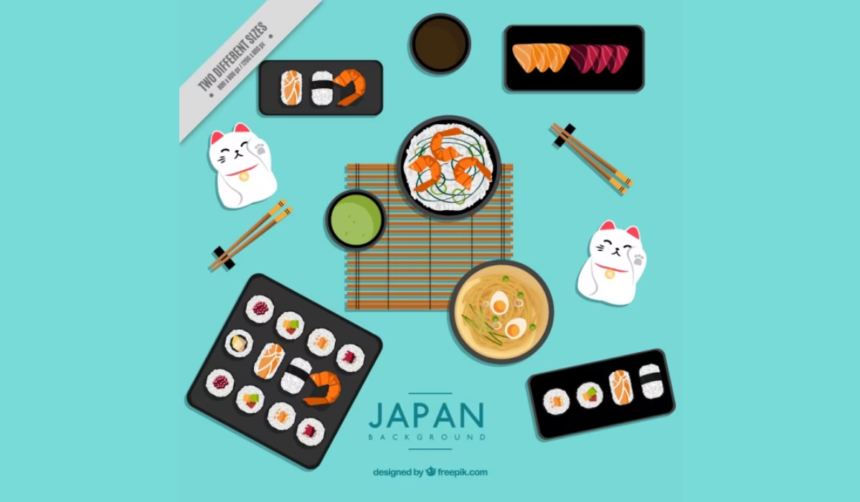A Taste of Japan: How Japanese Cuisine Reflects the Country’s Culture and History
Introduction
Japanese cuisine, or washoku, is renowned worldwide for its delicate flavors, fresh ingredients, and intricate presentation. But beyond just satisfying the taste buds, Japanese food also bears witness to the rich history and cultural traditions of the country. From ancient rituals to modern trends, Japanese cuisine reflects the values, beliefs, and people of Japan. In this article, we will delve into the fascinating world of Japanese cuisine and explore how it mirrors the country’s culture and history.
Origins of Japanese Cuisine
Japanese cuisine has its roots in the early Jomon period, when the first settlers in Japan relied on hunting, fishing, and gathering for their meals. Over time, the introduction of rice cultivation and trade with other countries brought new ingredients and cooking techniques to Japan. Chinese, Korean, and Portuguese influences can be seen in the development of Japanese cuisine, creating a unique blend of flavors and textures that are distinctively Japanese.
Rituals and Traditions
One of the most important aspects of Japanese cuisine is its connection to rituals and traditions. From the tea ceremony to the seasonal festivals, food plays a central role in Japanese culture. Traditional meals are often served in kaiseki, a multi-course format that showcases the season’s best ingredients and honors the relationship between food and nature. Even everyday meals are imbued with meaning and symbolism, reflecting the values of respect, harmony, and balance that are integral to Japanese society.
Key Ingredients in Japanese Cuisine
Japanese cuisine is characterized by its use of fresh, seasonal ingredients that are prepared with precision and care. Some of the key components of Japanese cuisine include rice, seafood, vegetables, and soy products. From sushi to tempura, these ingredients are used in a variety of dishes that highlight their natural flavors and textures. The attention to detail in selecting and preparing ingredients is a testament to the Japanese dedication to quality and craftsmanship.
Regional Variations
Japan is a diverse and geographically varied country, and this diversity is reflected in its cuisine. Each region of Japan has its own culinary traditions and specialties, influenced by local ingredients and climate. From the hearty dishes of Hokkaido to the delicate flavors of Kyoto, Japanese cuisine offers a wide range of tastes and styles that showcase the country’s culinary diversity. Traveling through Japan is like taking a culinary journey, experiencing the unique flavors and traditions of each region.
The Role of Presentation
Japanese cuisine is not only about the taste of the food but also about its presentation. The art of food presentation, known as “kaiseki,” is a key aspect of Japanese cooking that is rooted in the country’s aesthetic traditions. From the arrangement of dishes on the plate to the use of seasonal garnishes, every detail is carefully considered to create a visually stunning and harmonious meal. The emphasis on presentation reflects the Japanese appreciation for beauty and balance in all aspects of life.

Food as Art
In Japan, cooking is considered an art form, and chefs are revered for their skill and creativity. The culinary arts in Japan encompass a wide range of techniques, from sushi-making to wagashi (traditional sweets), that require years of training and dedication to master. Japanese chefs take pride in their craft and are always seeking to push the boundaries of culinary innovation, creating dishes that are both aesthetically pleasing and delicious. Food is not just sustenance in Japan – it is a form of artistic expression that reflects the beauty and sophistication of the country’s culture.
Influence of Zen Buddhism
Zen Buddhism has had a profound influence on Japanese cuisine, shaping the way food is prepared, consumed, and appreciated. The principles of mindfulness and simplicity that are central to Zen philosophy are reflected in the Zen-inspired approach to food, known as shojin ryori. This vegetarian cuisine emphasizes purity, balance, and natural flavors, using only the freshest ingredients and minimal seasoning. The Zen aesthetic of wabi-sabi, which values imperfection and impermanence, is also evident in the simplicity and elegance of Japanese dishes.
Innovations in Japanese Cuisine
While Japanese cuisine is steeped in tradition, it is also constantly evolving to adapt to changing tastes and trends. In recent years, Japanese chefs have been experimenting with fusion cuisine, blending traditional Japanese flavors with international influences to create new and exciting dishes. The rise of “washoku” as a UNESCO Intangible Cultural Heritage has also sparked a renewed interest in traditional Japanese cooking techniques and ingredients, leading to a revival of lost recipes and forgotten flavors.
Street Food Culture
Japanese street food, or yatai, is a vibrant and popular aspect of Japanese cuisine that offers a wide range of tasty treats to hungry passersby. From takoyaki (octopus balls) to yakitori (grilled chicken skewers), yatai vendors serve up delicious and affordable snacks that showcase the diverse flavors of Japanese cuisine. The informal and casual nature of yatai dining reflects the convivial spirit of Japanese society, where food is a source of pleasure and connection.
The Influence of Shintoism
Shintoism, the indigenous religion of Japan, plays a significant role in shaping Japanese cuisine and dining rituals. The principles of purity, reverence, and gratitude that are central to Shinto beliefs are reflected in the traditional practices of Japanese dining, such as saying “itadakimasu” before a meal and “gochisosama deshita” after finishing. Food is seen as a gift from the gods, and the act of eating is imbued with spiritual significance, reminding people to be grateful for the nourishment and sustenance they receive.
Health Benefits of Japanese Cuisine
Japanese cuisine is not only delicious but also healthy, with its emphasis on fresh ingredients, balanced flavors, and mindful eating. The Japanese diet is rich in seafood, vegetables, and fermented foods, which are known for their health benefits and longevity-promoting properties. The low-fat, high-fiber nature of Japanese cuisine has been linked to lower rates of obesity, heart disease, and other chronic illnesses, making it one of the healthiest diets in the world.
Global Influence of Japanese Cuisine
Japanese cuisine has captured the hearts and palates of food lovers around the world, with sushi, ramen, and tempura becoming popular staples in international cuisine. The Japanese emphasis on quality, freshness, and innovation has inspired chefs and food enthusiasts worldwide to embrace the principles of washoku in their own cooking. Japanese restaurants can be found in nearly every corner of the globe, serving up authentic flavors and traditional dishes that offer a taste of Japan to diners far and wide.
Conclusion
In conclusion, Japanese cuisine is more than just food – it is a reflection of the country’s culture, history, and values. From the origins of Japanese cuisine in ancient rituals to the modern innovations and global influence of Japanese cooking, washoku is a testament to the richness and diversity of Japan’s culinary heritage. As you savor the flavors of sushi, tempura, and miso soup, take a moment to appreciate the traditions and stories that are woven into every bite. Let the taste of Japan transport you to a world of beauty, harmony, and deliciousness. Kampai! (Cheers!)
FAQs about “A Taste of Japan: How Japanese Cuisine Reflects the Country’s Culture and History”
- What makes “A Taste of Japan: How Japanese Cuisine Reflects the Country’s Culture and History” a captivating exploration of Japanese gastronomy? This book offers a captivating exploration of Japanese cuisine, showcasing how it reflects the country’s rich culture and history. It provides insights into the unique flavors, ingredients, and culinary traditions that define Japanese gastronomy.
- How does Japanese cuisine reflect the culture and history of Japan? Japanese cuisine is deeply intertwined with the culture and history of Japan, reflecting its emphasis on seasonality, simplicity, and harmony. It incorporates traditional ingredients, cooking techniques, and dining rituals that have been passed down through generations.
- Are specific Japanese dishes featured in this book to illustrate cultural and historical influences? Yes, “A Taste of Japan” features a variety of Japanese dishes that illustrate the cultural and historical influences on Japanese cuisine. From sushi and tempura to ramen and kaiseki, each dish is accompanied by insights into its origins, significance, and role in Japanese culinary culture.
- How does this book delve into the cultural and historical context of Japanese cuisine? This book delves into the cultural and historical context of Japanese cuisine by exploring its origins, evolution, and regional variations. It discusses how factors such as geography, religion, and social customs have shaped Japanese culinary traditions over time.
- Can readers expect to gain a deeper appreciation for Japanese cuisine and culture from this book? Absolutely! “A Taste of Japan” provides readers with a deeper appreciation for Japanese cuisine and culture by offering a comprehensive overview of its cultural and historical significance. Whether you’re a food enthusiast or a curious traveler, this book offers valuable insights into the fascinating world of Japanese gastronomy.
Advantages:
- Evocative Language: The title “A Taste of Japan: How Japanese Cuisine Reflects the Country’s Culture and History” immediately captures attention by suggesting a sensory experience and highlighting the close connection between Japanese cuisine, culture, and history.
- Cultural Exploration: By emphasizing the reflection of Japanese culture and history in its cuisine, the title invites readers to delve into the cultural and historical context that shapes Japanese cooking, fostering a deeper appreciation for Japan’s culinary heritage.
- Gastronomic Insight: Readers can anticipate gaining a comprehensive understanding of Japanese cuisine, as the title promises to explore how various dishes, ingredients, and cooking techniques reflect different aspects of Japanese culture and history.
- Educational Value: The title offers educational value by providing insights into the cultural significance and symbolism of Japanese cuisine, enriching readers’ understanding of Japan’s culinary traditions.
- Inspiration for Appreciation: The title may inspire readers to develop a deeper appreciation for Japanese cuisine and culture, encouraging them to explore Japanese dishes, ingredients, and cooking methods.
Disadvantages:
- Generalization: While the title suggests a broad exploration of Japanese cuisine, it may oversimplify the diversity and complexity of regional cuisines within Japan, potentially overlooking lesser-known dishes and culinary traditions.
- Cultural Oversimplification: Focusing solely on how Japanese cuisine reflects culture and history may oversimplify the multifaceted nature of Japanese culture, overlooking other important aspects beyond food.
- Limited Scope: The title may not fully capture the depth and intricacies of Japanese cuisine’s relationship with culture and history, potentially leaving out certain aspects or perspectives that could provide a more comprehensive understanding.
- Potential Misrepresentation: Without careful analysis and context, highlighting the reflection of culture and history in Japanese cuisine could lead to misinterpretation or stereotyping of Japanese culinary traditions.
- Lack of Specificity: The title does not specify which aspects of Japanese cuisine, culture, or history will be explored, leaving readers uncertain about the specific focus or content of the discussion.
















